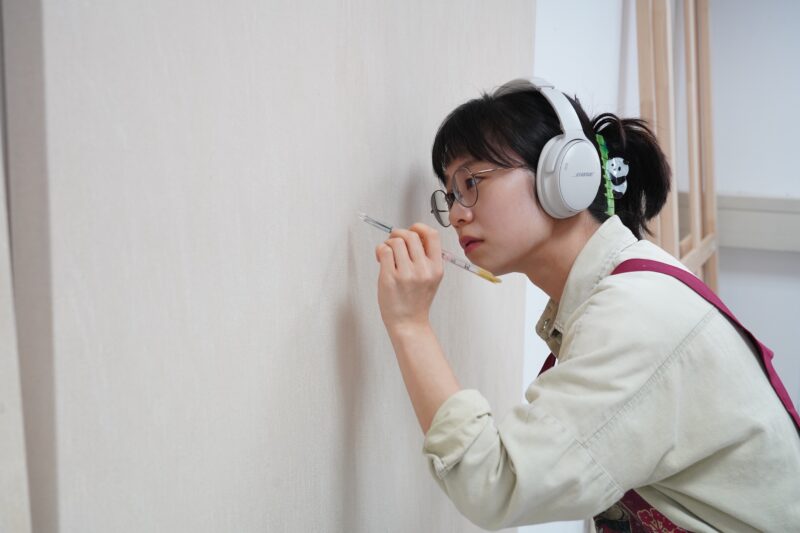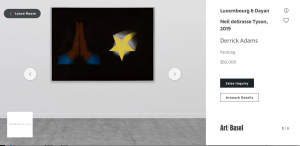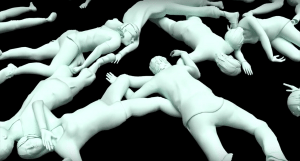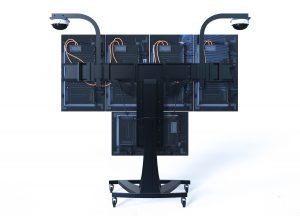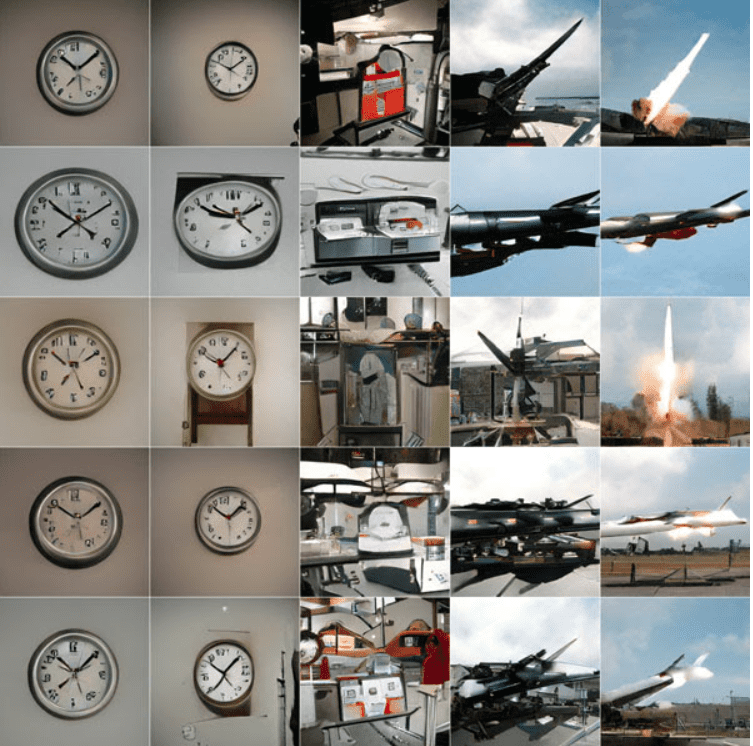
Yuri Pattison’s exhibition clock speed (the world on time), at mother’s tankstation, London explores notions of temporality, artifice, and (re)presentation. The status of time as a fundamental aspect of the universe has been the subject of debate among physicists since the late nineteenth century. ‘Time’s Arrow’, the ostensibly objective metaphor for the action of entropy, suggests a kind of universality to the nature of time. Nevertheless, time is experienced subjectively, and this experience is quantised, managed, and enforced through regimes of politics and power; temporal economies have other, more personal faces. From the concept of the ‘attention economy’, adumbrated by Davenport and Beck, extended as ‘ambient’ informational acculturation by Malcolm McCullough, as well as the newsfeeds consumed by social media users in their ‘timelines’, the ways in which information is distributed, represented, and symbolised within time exert major impacts on understandings of temporality. As the psychologist Virginie van Wassenhove’s research has discussed, the relationship of subjectivity to time is not simply a matter of linear experience, but also the valences attached to specific forms of information.
In clock speed Pattison critically explores these sites of perceptual and material contestation. In clock speed (the dead), [all works 2022], Pattison examines the way machine intelligence understands and recapitulates representations of time: A ‘clock’ is constructed by probing stock image categories within DeepMind’s BigGAN – revealing what the engineers at DeepMind (GoogleAlphabet) believe constitute the modern world. The militarised infrastructural components of modernity, including tanks, oil rigs, and warplanes punctuate abstract images of clock faces. Systems such as DeepMind ‘understand’ how a clock looks, but not what it does, or why; such agnosticism creates a surface coherency which licenses forward structural progression without meaningful knowledge, recapitulating past power dynamics to create a necrotic cycle. The geopolitics of time are a central feature of world clock, reflector timeline (east), and world clock, reflector timeline (west). These large, wall-based panel works are activated by frequencies from the USA’s GPS service and GLONASS, Russia’s satellite navigation system. Signals are received via GNSS receivers and converted to audible range using circuits built by a former timing technician from the Greenwich Maritime Museum, then amplified. Emitting a low volume hum that permeates the space – evoking the kind of ambient presence infrastructural time exerts over geopolitical space. Both panels visually present collages of found and original images as abstracted and subjective timelines intersecting the pandemic, the Ukraine war, and images from Pattison’s own life.
Personal narratives are also at the heart of cuttings, a sculpture featuring a rudimentary model of a Khrushchyovka. While the work is of a specific Khrushchyovka where Pattison’s grandmother’s family lived, the format was widely used in Soviet-era building for the production of units that defined a literal ‘standard’ of living for generations. Within this replica is a large cutting from an Aloe plant smuggled from Ukraine to Ireland and now to London (via Paris) taken from the original generation at Pattison’s grandmother’s home. The building in cuttings is rendered using Google Street View and Pattison’s own memories of the space, and is housed in metal standardised pallets, drawing connections to earlier works by Pattison involving these structures. Within the work, a sunlight simulation lamp serves as a light box for a photograph of Pattison’s grandmother’s flat. This dimension also serves as a means of illuminating the plant which appears to grow through two rendered pallets the forms of which are based on the original Khrushchyovka; thus the plant can appear to sprout from the sculpture, or from the building itself, depending on how it is viewed. As a last touch, the soil in which the cutting is potted is ‘enriched’ using shredded Euro notes, inscribing the complex economic dynamics at play with regard to housing in both the post-Soviet space and in Western Europe where various countries’ housing markets have become money sinks for wealth of uncertain provenance.
The manifestation of information as ideology and symbol is one of the key themes of barricades (books by the metre), which takes its title from bespoke book purchasing services that deliver large quantities of books with prices based on size. Pattison conceptualised the work watching political interviews in which shelves of books appear in the background of images. These deeply ideological representations of home environments often can be seen in information flows from the Ukraine war, some of which featured images of civilian dwellings using piles of books as a means of defending themselves against flying glass generated by Russian bombing. The books in Pattison’s installation are wrapped in plain jackets, and, thus, appear interchangeable, alluding to both the ostensible ‘reality’ of the interview backdrops and the alternative uses of the materiality of books as technologies in Ukraine. The work considers the book as a technology as well as a material object. The informational content symbolically presumed by displaying a book is belied by the books’ visual neutralisation reflecting the strange position of the hyper-informed yet disempowered subject characteristic of the present political moment. Information as prophylaxis, or even defense, has come to mean little in an age of relentless infrastructural enclosure of politics and power.
Yuri Pattison clock speed (the world on time) mother’s tankstation | London 13th May – 2nd July 2022
About the artist
Yuri Pattison is a tireless, natural thinker at the forefront of a group of emerging artists / intellectuals whose practices, in an inherently 21st century manner, are informed by a seamless merger of hard and soft realities. He works in sculpture and digital media, exploring the visual culture of digital economies and the natures of online/offline skill sharing. Typical, recent examples of his artworks thoughtfully list medium and/or displayed interior contents, as if listed by border security agents: “custom made perspex 1U format box, server PSU & switch, server case fans, AI: The Tumultuous History of the Search for Artificial Intelligence, by Daniel Crevier (book), PDLC switchable privacy film, cables, generic unpainted architectural 1:100 scale model figures, dust, sebum [an oily secretion of the sebaceous glands], digital timers, travel power adapter…”
Pattison’s third solo exhibition with mother’s tankstation, to-do, doing, done, opened in our London gallery in September 2019. Pattison will present his fourth solo exhibition at the gallery in Spring 2022 at our London gallery. Recent notable exhibitions include: One Escape at a Time, the 11th Seoul Mediacity Biennale, Seoul (2021); the engine, Douglas Hyde Gallery, Dublin (solo, 2020), Phantom Plane, Cyberpunk in the Year of the Future, Tai Kwun Contemporary, Hong Kong (2019), Trusted Traveller, Kunsthalle Sankt Gallen, Switzerland (solo, 2017) and citizens of nowhere, Kevin Space, Vienna (solo, 2017). In 2018, Pattison was awarded the Luma Arles Residency in France and in December 2017, he was one of four artists commissioned to make a new work for The Everywhere Studio, the inaugural exhibition at the ICA Miami. Earlier on that same year, an indicative installation was acquired by the Irish Museum of Modern Art. Yuri Pattison also holds considerable UK curatorial updraft, with a major work the ideal (v. 0.1) presented as part of British Art Show 8, 2015-2017, and he was the recipient of the 2016 Frieze Artist Award, culminating in a major new commission Insights (crisis trolley). The Weight of Data, Tate Britain, 2015, curated by Lizzie Carey Thomas, which also included a breakthrough video sculpture colocation, time displacement. His practice was the focus of the prestigious two-year CREATE residency at Chisenhale Gallery, London, which concluded with a major solo show, user, space, curated by Polly Staple in 2016. Pattison will be included in group exhibition Radical Landscapes at Tate Liverpool in Spring 2022.
